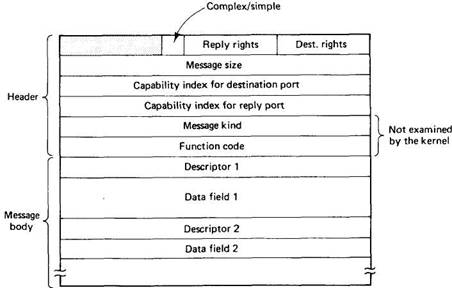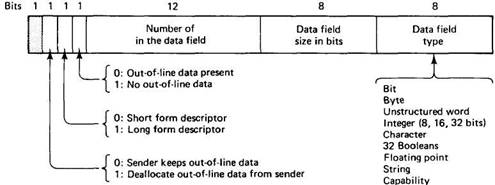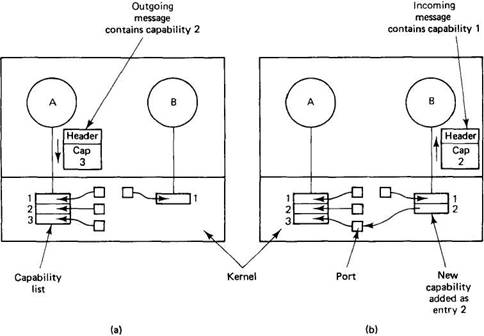Книга: Distributed operating systems
8.4.2. Sending and Receiving Messages
8.4.2. Sending and Receiving Messages
The purpose of having ports is to send messages to them. In this section we will look at how messages are sent, how they are received, and what they contain. Mach has a single system call for sending and receiving messages. The call is wrapped in a library procedure called mach_msg. It has seven parameters and a large number of options. To give an idea of its complexity, there are 35 different error messages that it can return. Below we will give a simplified sketch of some of its possibilities. Fortunately, it is used primarily in procedures generated by the stub compiler, rather than being written by hand.
The mach_msg call is used for both sending and receiving. It can send a message to a port and then return control to the caller immediately, at which time the caller can modify the message buffer without affecting the data sent. It can also try to receive a message from a port, blocking if the port is empty, or giving up after a certain interval. Finally, it can combine these two operations, first sending a message and then blocking until a reply comes back. In the latter mode, mach_msg can be used for RPC.
A typical call to mach_msg looks like this:
mach_msg(&hdr,options,send_size,rcv_size,rcv_port,timeout,notify_port);
The first parameter, hdr, is a pointer to the message to be sent or to the place where the incoming message is put, or both. The message begins with a fixed header and is followed directly by the message body. This layout is shown in Fig. 8-17. We will explain the details of the message format later, but for the moment just note that the header contains a capability name for the destination port. This information is needed so that the kernel can tell where to send the message. When doing a pure RECEIVE, the header is not filled in, since it will be overwritten entirely by the incoming message.
The second parameter of the mach_msg call, options, contains a bit specifying that a message is to be sent, and another one specifying that a message is to be received. If both are on, an RPC is done. Another bit enables a timeout, given by the timeout parameter, in milliseconds. If the requested operation cannot be performed within the timeout interval, the call returns with an error code. If the SEND portion of an RPC times out (e.g., due to the destination port being full too long), the receive is not even attempted.

Fig. 8-17. The Mach message format.
Other bits in options allow a SEND that cannot complete immediately to return control anyway, with a status report being sent to notify_port later. All kinds of errors can occur here if the capability for notify_port is unsuitable or changed before the notification can occur. It is even possible for the call to ruin notify_port itself (calls can have complex side effects, as we will see later).
The mach_msg call can be aborted part-way through by a software interrupt. Another options bit tells whether to give up or try again.
The send_size and rcv_size parameters tell how large the outgoing message is and how many bytes are available for storing the incoming message, respectively. Rcv_port is used for receiving messages. It is the capability name of the port or port set being listened to.
Now let us turn to the message format of Fig. 8-17. The first word contains a bit telling whether the message is simple or complex. The difference is that simple messages cannot carry capabilities or protected pointers, whereas complex ones can. Simple messages require less work on the part of the kernel and are therefore more efficient. Both message types have a system-defined structure, described below. The message size field tells how big the combined header plus body is. This information is needed both for transmission and by the receiver.
Next come two capability names (i.e., indices into the sender's capability list). The first specifies the destination port; the second can give a reply port. In client-server RPC, for example, the destination field designates the server and the reply field tells the server which port to send the response to.
The last two header fields are not used by the kernel. Higher levels of software can use them as desired. By convention, they are used to specify the kind of message and give a function code or operation code (e.g., to a server, is this request for reading or for writing?). This usage is subject to change in the future.
When a message is sent and successfully received, it is copied into the destination's address space. It can happen, however, that the destination port is already full. What happens then depends on the various options and the rights associated with the destination port. One possibility is that the sender is blocked and simply waits until space becomes available in the port. Another is that the sender times out. In some cases, it can exceed the port limit and send anyway.
A few issues concerning receiving messages are worth mentioning. For one, if an incoming message is larger than the buffer, what should be done with it? Two options are provided: throw it away or have the mach_msg call fail but return the size, thus allowing the caller to try again with a bigger size.
If multiple threads are blocked trying to read from the same port and a message arrives, one of them is chosen by the system to get the message. The rest remain blocked. If the port being read from is actually a port set, it is possible for the composition of the set to change while one or more threads are blocked on it. This is probably not the place to go into all the details, but suffice it to say that there are precise rules governing this and similar situations.
Message Formats
A message body can be either simple or complex, controlled by a header bit, as mentioned above. Complex messages are structured as shown in Fig. 8-17. A complex message body consists of a sequence of (descriptor, data field) pairs. Each descriptor tells what is in the data field immediately following it. Descriptors come in two formats, differing only in how many bits each of the fields contains. The normal descriptor format is illustrated in Fig. 8-18. It specifies the type of the item that follows, how large an item is, and how many of them there are (a data field may contain multiple items of the same type). The available types include raw bits and bytes, integers of various sizes, unstructured machine words, collections of Booleans, floating-point numbers, strings, and capabilities. Armed with this information, the system can attempt to do conversions between machines when the source and destination machines have different internal representations. This conversion is not done by the kernel but by the network message server (described below). It is also done for internode transport even for simple messages (also by the network message server).
One of the more interesting items that can be contained in a data field is a capability. Using complex messages it is possible to copy or transfer a capability from one process to another. Because capabilities are protected kernel objects in Mach, a protected mechanism is needed to move them about.

Fig. 8-18. A complex message field descriptor.
This mechanism is as follows. A descriptor can specify that the word directly after it in the message contains the name for one of the sender's capabilities, and that this capability is to be passed to the receiving process and inserted in the receiver's capability list. The descriptor also specifies whether the capability is to be copied (the original is not touched) or moved (the original is deleted).
Furthermore, certain values of the Data field type ask the kernel to modify the capability's rights while doing the copy or move. A RECEIVE capability, for example, can be mutated into a SEND or SEND-ONCE capability, so that the receiver will have the power to send a reply to a port for which the sender has only a RECEIVE capability. In fact, the normal way to establish communication between two processes is to have one of them create a port and then send the port's RECEIVE capability to the other one, turning it into a SEND capability in flight.
To see how capability transport works, consider Fig. 8-19(a). Here we see two processes, A and B, with 3 capabilities and 1 capability, respectively. All are RECEIVE capabilities. Numbering starts at 1 since entry 0 is the null port. One of the threads in A is sending a message to B containing capability 3.
When the message arrives, the kernel inspects the header and sees that it is a complex message. It then begins processing the descriptors in the message body, one by one. In this example there is only one descriptor, for a capability, with instructions to turn it into a SEND (or maybe SEND-ONCE) capability. The kernel allocates a free slot in the receiver's capability list, slot 2 in this example, and modifies the message so that the word following the descriptor is now 2 instead of 3. When the receiver gets the message, it sees that it has a new capability, with name (index) 2. It can use this capability immediately (e.g., for sending a reply message).

Fig. 8-19. (a) Situation just before the capability is sent. (b) Situation after it has arrived.
There is one last aspect of Fig. 8-18 that we have not yet discussed: out-of-line data. Mach provides a way to transfer bulk data from a sender to a receiver without doing any copying (on a single machine or multiprocessor). If the out-of-line data bit is set in the descriptor, the word following the descriptor contains an address, and the size and number fields of the descriptor give a 20-bit byte count. Together these specify a region of the sender's virtual address space. For larger regions, the long form of the descriptor is used.
When the message arrives at the receiver, the kernel chooses an unallocated piece of virtual address space the same size as the out-of-line data, and maps the sender's pages into the receiver's address space, marking them copy-on-write. The address word following the descriptor is changed to reflect the address at which the region is located in the receiver's address space. This mechanism provides a way to move blocks of data at extremely high speed, because no copying is required except for the message header and the two-word body (the descriptor and the address). Depending on a bit in the descriptor, the region is either removed from the sender's address space or kept there.
Although this method is highly efficient for copies between processes on a single machine (or between CPUs in a multiprocessor), it is not as useful for communication over a network because the pages must be copied if they are used, even if they are only read. Thus the ability to transmit data logically without moving physically them is lost. Copy-on-write also requires that messages be aligned on page boundaries and be an integral number of pages in length for best results. Fractional pages allow the receiver to see data before or after the out-of-line data that it should not see.
- 9.4.1.Messages
- 7.6.2 Sending and Receiving Messages
- Разработка приложений баз данных InterBase на Borland Delphi
- Open Source Insight and Discussion
- Introduction to Microprocessors and Microcontrollers
- Chapter 6. Traversing of tables and chains
- Chapter 8. Saving and restoring large rule-sets
- Chapter 11. Iptables targets and jumps
- Chapter 5 Installing and Configuring VirtualCenter 2.0
- Chapter 16. Commercial products based on Linux, iptables and netfilter
- Appendix A. Detailed explanations of special commands
- Appendix B. Common problems and questions




